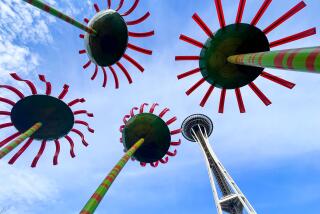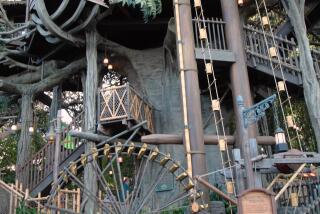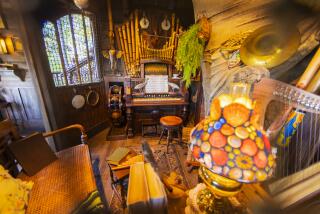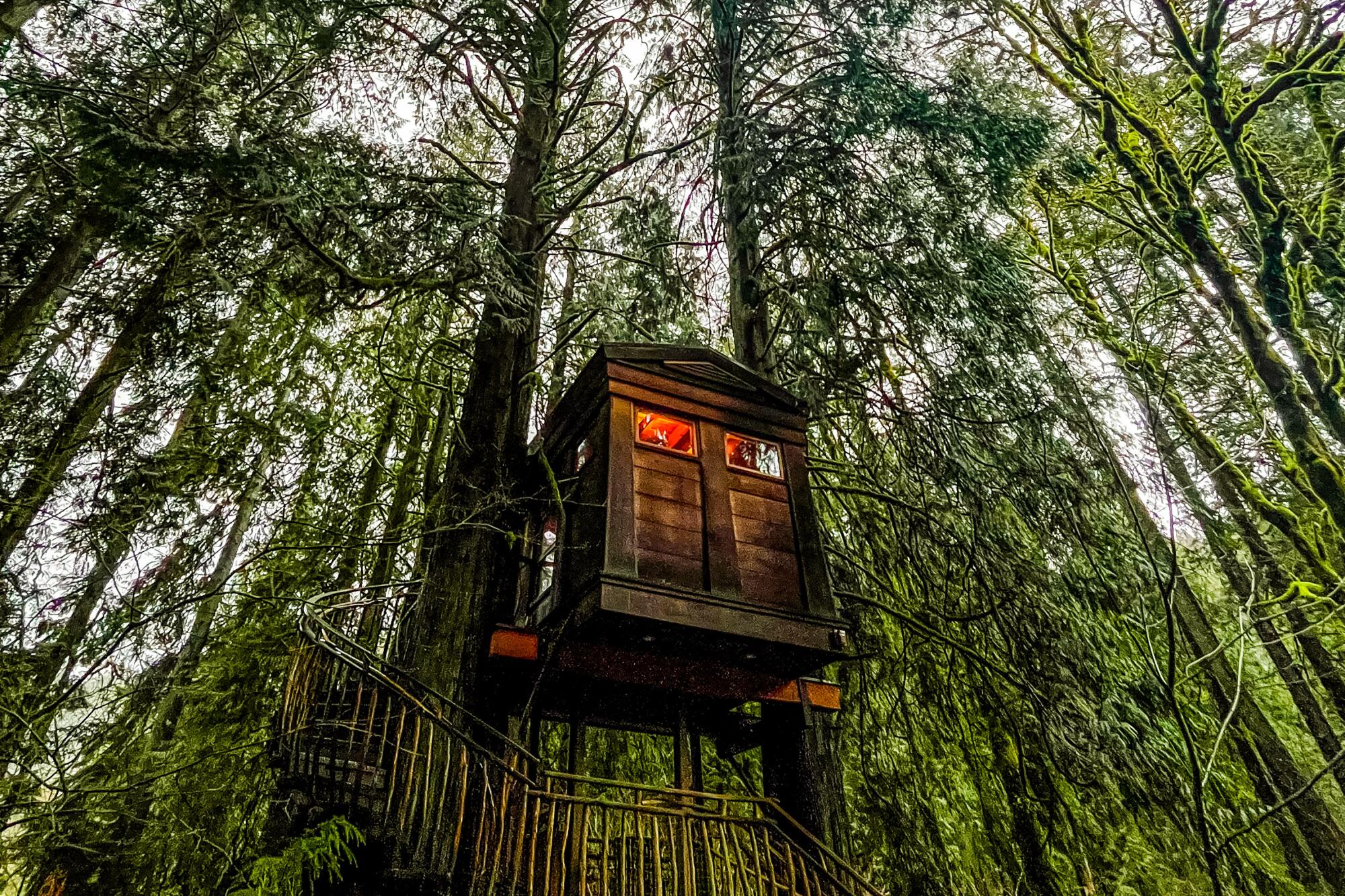
- Share via
The drive to Treehouse Point, half an hour east of Seattle, takes you through a forest fit for hobbits, crowded full of fir, spruce, cedar, maple and hemlock. Alongside the Raging River — yes, that’s its name — you get to a gate, punch in the secret code and enter a realm where it’s perfectly normal to sleep in a tree, surrounded by clever carpentry and birdsong.
It’s a treehouse hotel, with seven elevated perches spread among the greenery.
Like a Douglas fir in rich soil, Treehouse Point has been growing for 19 years, propelled in part by creator Pete Nelson’s fame as a treehouse designer and the former host of “Treehouse Masters” on Animal Planet.
The property’s treehouses, each unique and uniquely named, are priced at $325 to $625 a night, breakfast included. Five have water-flush toilets and sinks aboard. The Upper Pond unit has a composting toilet and the Bonbibi unit relies on access to the bathhouse’s toilets and showers.
Now that I’ve spent a rainy winter night in one of the treehouses, I can tell you that this setting was spectacular, the room was snug as a lumberjack’s lunchbox. (And later, I learned why it made me feel like I was in a cabin on a ship.)
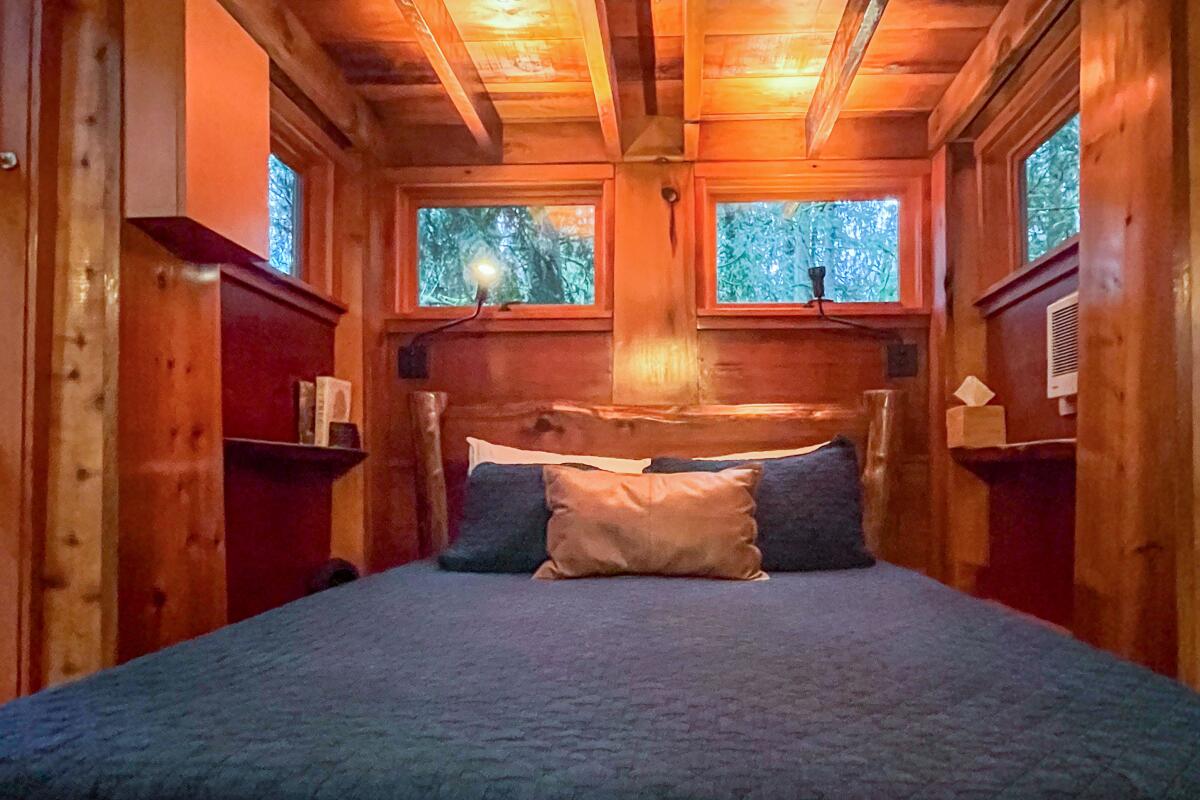
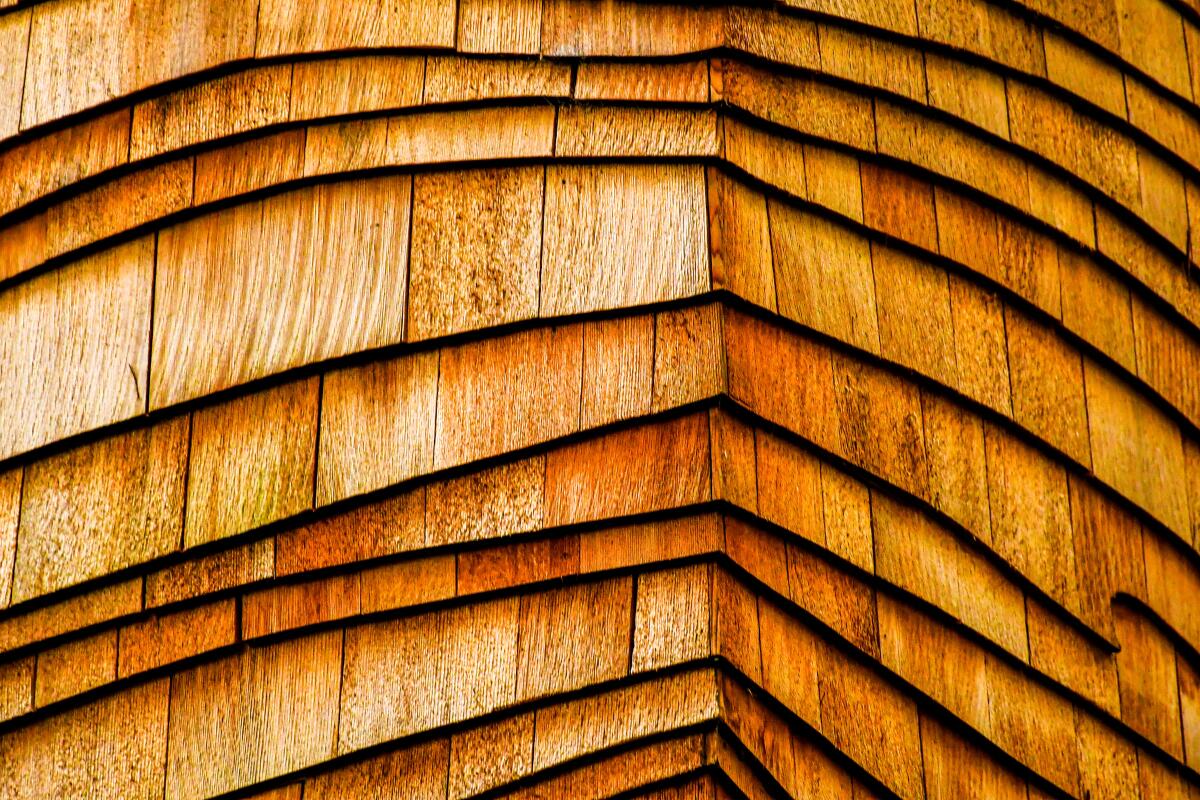
The interior at left is Treehouse Point’s Bonbibi unit. At right is a shingled wall from the Ananda unit. (Christopher Reynolds / Los Angeles Times)
The story of these treehouses begins in the mid-1960s in Ridgewood, N.J., where 7-year-old Pete Nelson’s father put up a backyard treehouse. Years later, after meeting his wife-to-be, Judy, at Colorado College in Colorado Springs, Colo., Nelson set about building a treehouse himself. Then another.
Treehouses, Pete Nelson wrote later, “speak in an ancient language and the message is universal: Climb up and be in harmony with nature.”
By 1994, he had published “ Treehouses: The Art and Craft of Living Out on a Limb,” a coffee-table book. “How could Peter Nelson’s ‘Treehouses’ fail to please?” wrote L.A. Times reviewer Tobi Tobias. “Its subject is immediately attractive, with its implications of escape and fantasy.” Several similar volumes have followed.
Pete and Judy Nelson bought the Treehouse Point property in Fall City in 2005, beginning with four largely raw riverside acres. The first treehouse, Temple of the Blue Moon, was completed in 2006. Since then, despite early tangles with King County building inspectors and the economic slump of 2008, the Nelsons have built seven treehouses, a central lodge (with a guest bedroom), an event space (with a shower and toilet) and a bathhouse, neighbored by a pond and a wedding lawn.
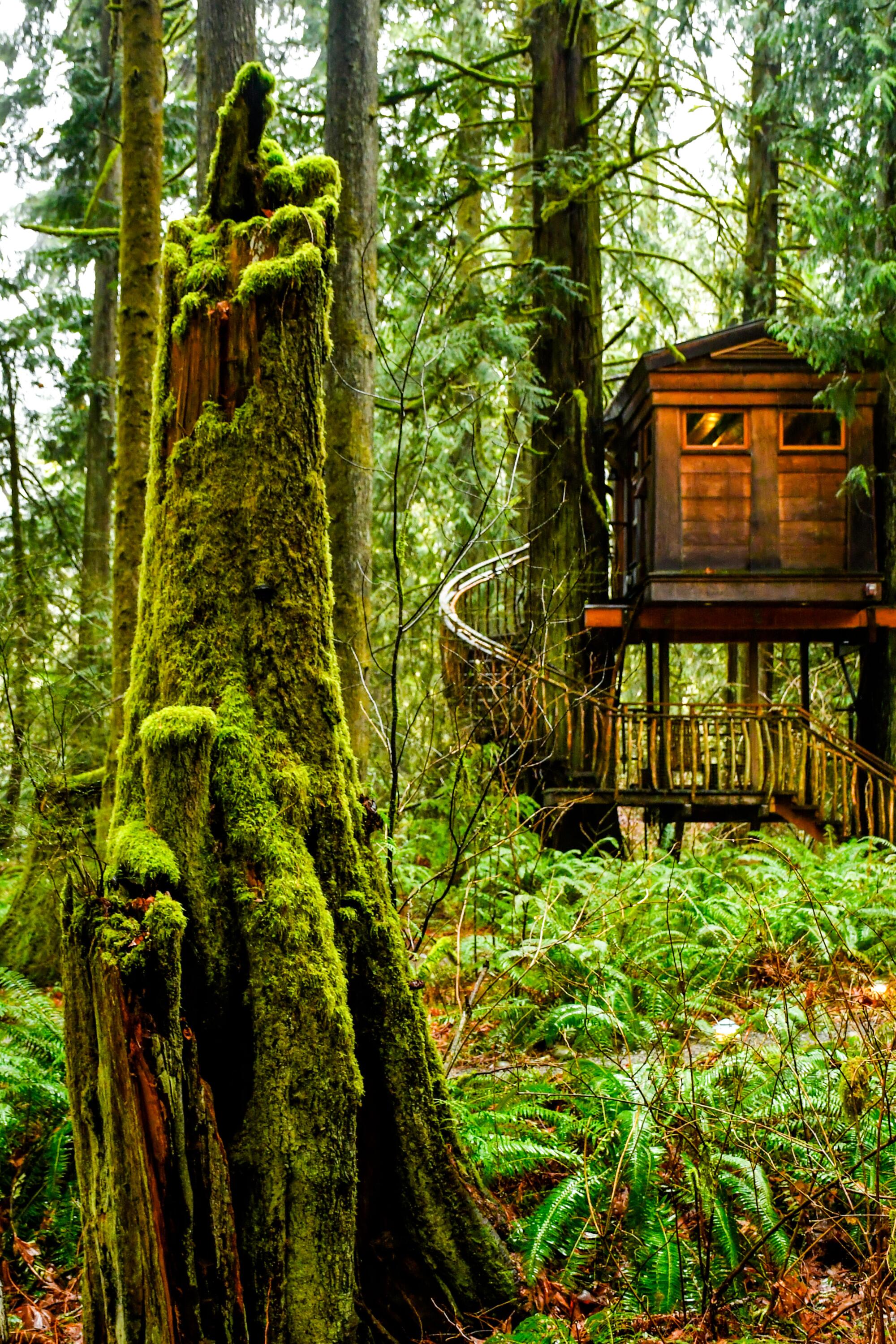
The most recent unit, Ananda, was built in 2021 to be wheelchair accessible. There’s also a path down to the river’s edge, where you could try to skip a stone or just marvel at the lichen-swaddled tree trunks leaning over the fast water.
The most popular units? Temple of the Blue Moon, followed by Ananda.
The most affordable treehouse? That would be my room, Bonbibi, named for a Bangladeshi goddess of the forest.
As I approached its spiral staircase on a short path through the forest, I encountered a tour group, dazzled and beaming after a stroll to the river.
“You’re staying overnight?” one of the visitors asked me, envy in every syllable.
At the top of Bonbibi’s stairs, I found a 9- by-12-foot room affixed to the broad trunk of a western red cedar.
Below, there’s an outdoors sitting area with a pair of chairs. Once you’ve stepped inside, there’s a queen bed, plenty of electricity, a coffee maker, several big windows with white curtains and just about everything you’d expect in an upscale hotel.
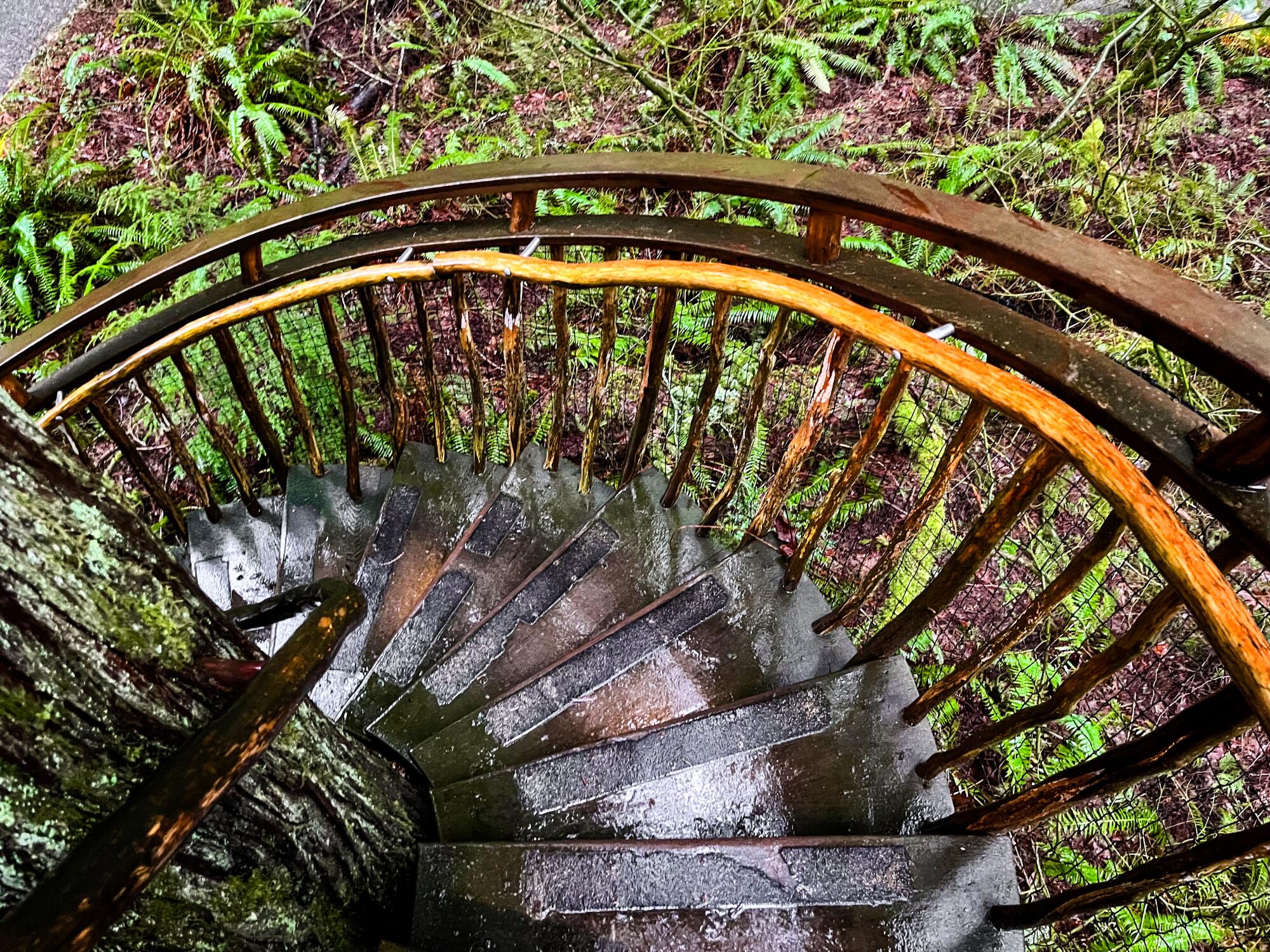
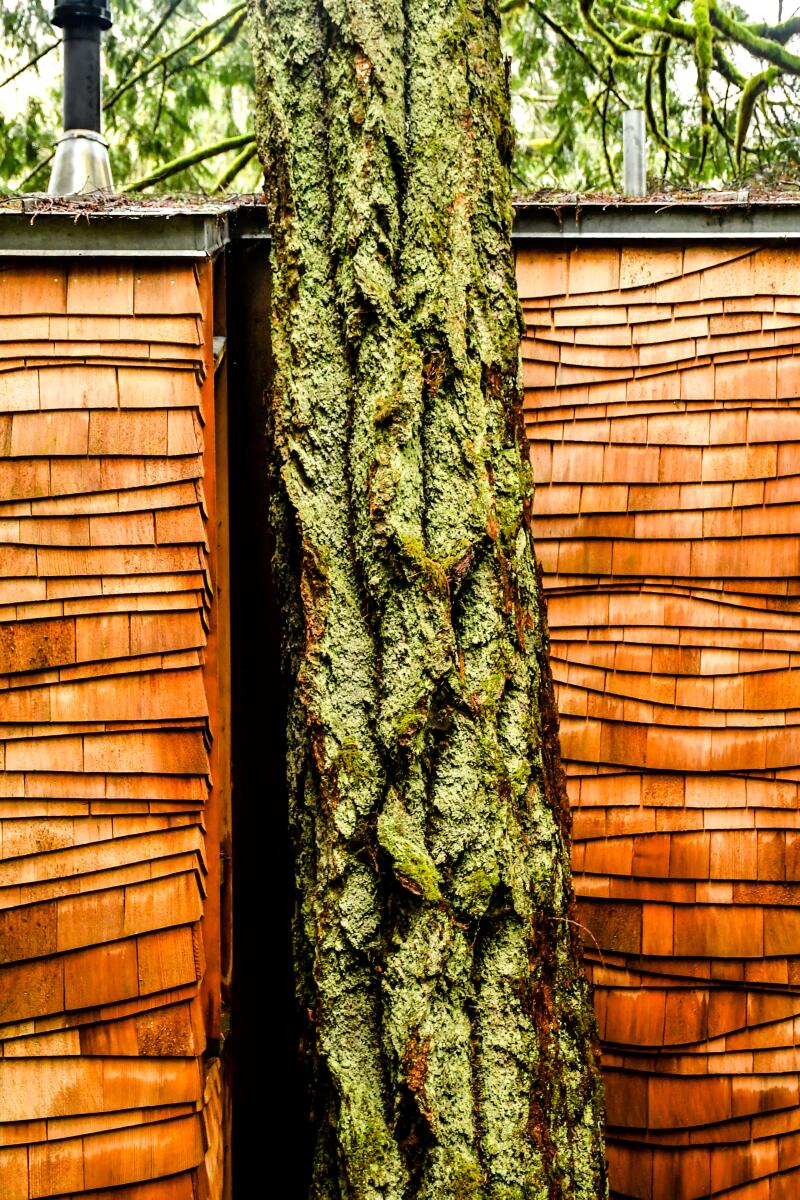
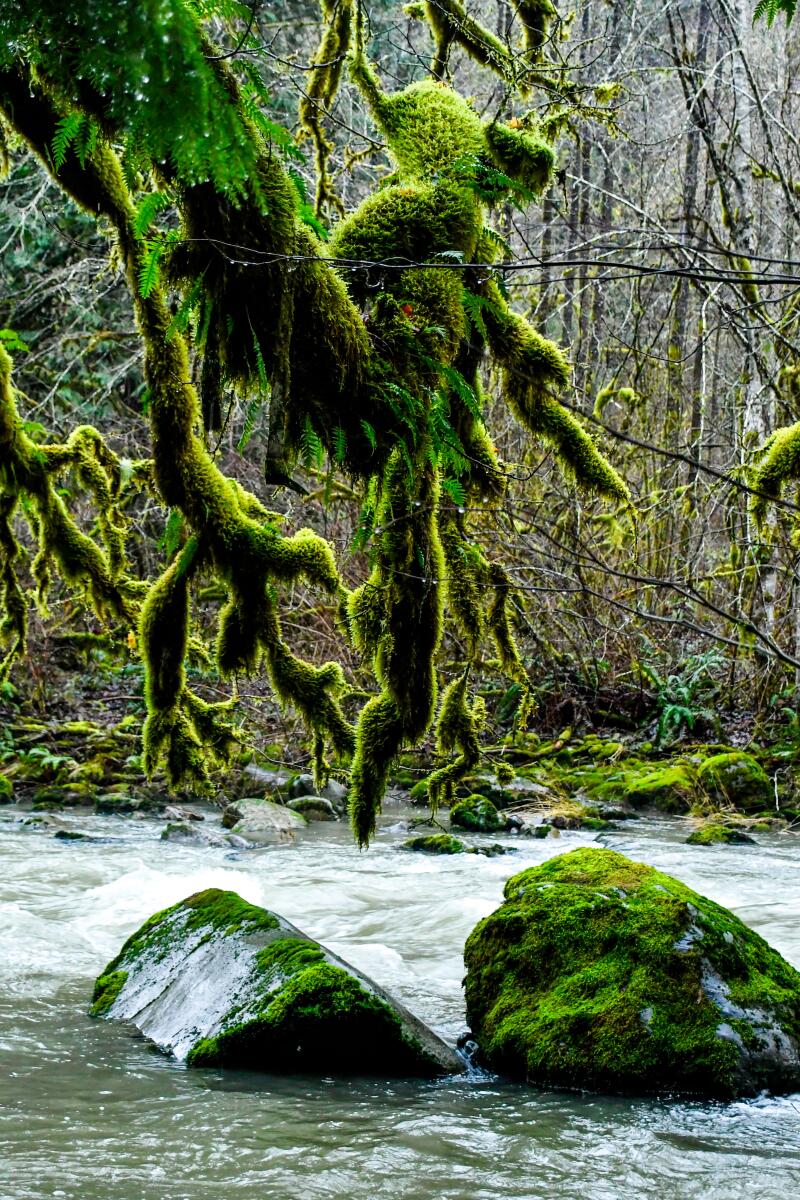
Treehouse Point’s Bonbibi unit includes a staircase that wraps around the host tree’s trunk. Another unit’s shingles snugly fit near living trunks and branches. The treehouses neighbor the Raging River. (Christopher Reynolds / Los Angeles Times)
Those amenities include a relatively quiet heating-air conditioning unit. Still, for much of the night, I turned it off because the temperature was stable and the sounds of the river, rain and forest, with no hum at all, were irresistible.
It’s probably not a coincidence that TreeHouse Point has grown along with the Nelsons’ fame.
With partners, the Nelsons now have a hand in three other treehouse getaways: Treehouse Utopia in the Texas Hill Country ; the Woods Maine in Norway, Maine; and Treehouse Grove at Norton Creek Resort in Gatlinburg, Tenn. In addition, through Nelson Treehouse & Suppy, Pete Nelson spends much of his time designing and building treehouses nationwide.
Meanwhile, it turns out that many brides and grooms love the idea of spending their wedding nights in a tree. TreeHouse Point has evolved into a busy wedding venue, hosting 80 or more ceremonies per year — “up to four a week,” said general manager Bree Monahan. (Neither of the Nelsons, who travel often, was on hand during my visit.)
For nonwedding guests, there’s usually a two-night minimum. (Sunday nights are a good bet if you want to sidestep that.) Treehouse Point doesn’t allow guests under age 16 or pets. In order to preserve privacy for guests, management doesn’t allow check-ins before 4 p.m. or check-outs after 11 a.m., or drop-in visits by curious passers-by.
There are, however, yoga classes on most Tuesdays and Thursdays, and visitors can book midday tours, typically an hour for $35. There probably won’t be any new treehouses coming along, Monahan said, because the operation has reached its maximum number of permitted lodgings.
It’s a fascinating place to prowl, almost ridiculously photogenic. I couldn’t enter any units other than my own, but to me, the architectural star of the show is Trillium, a two-level wonder with 80 window panes, all clinging to the ample trunk of a western red cedar. It was completed in 2009.
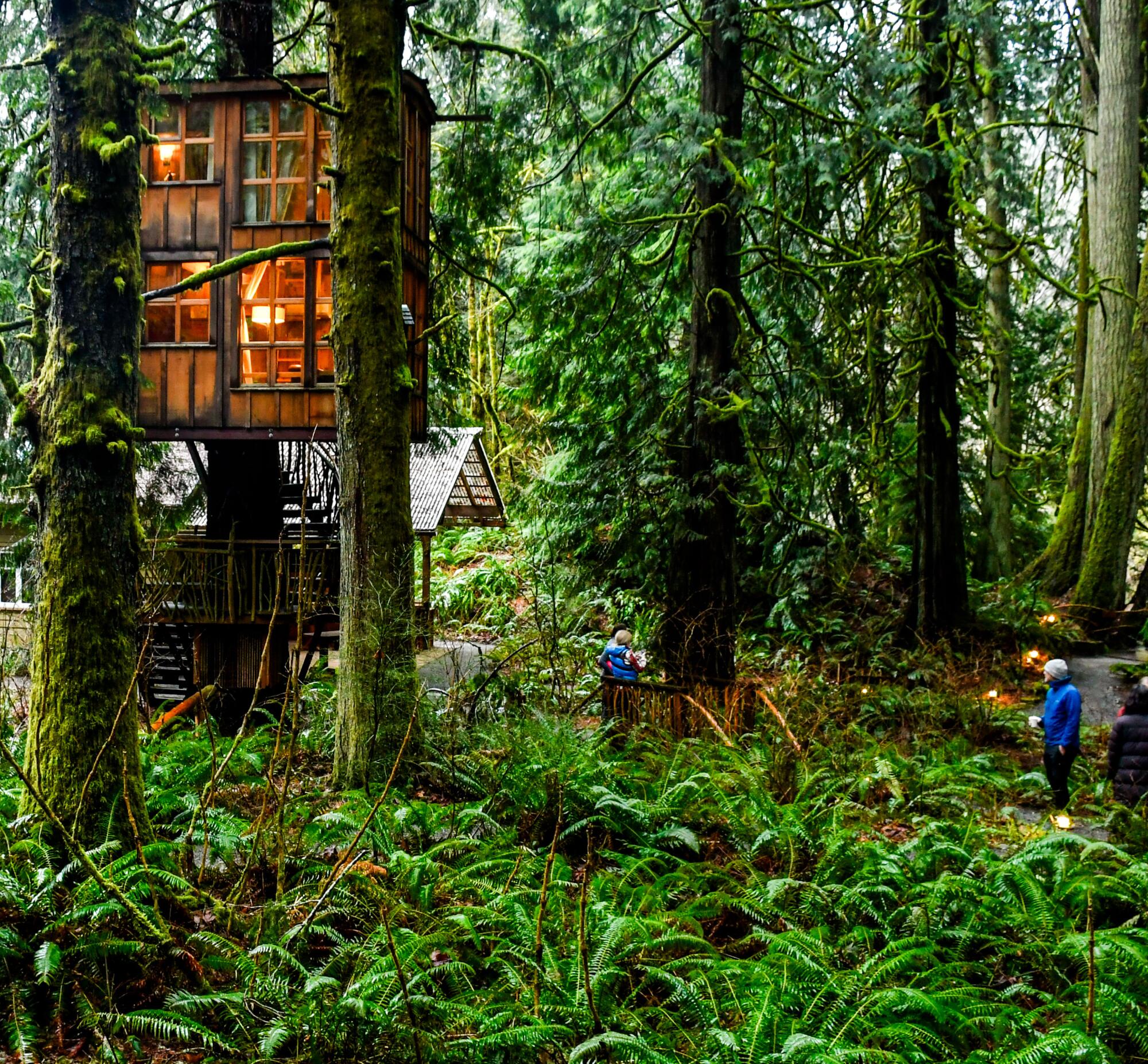
Later, I learned that my room, Bonbibi, started out as a 2010 treehouse-building workshop project — an elevated gazebo, built in five days, including a ship’s ladder, the interior finished with marine spar varnish. When the Nelsons expanded it into an overnight lodging in 2012, they replaced the ship’s ladder with the spiral stairs. But the upstairs still feels, as Nelson has written, “like a state room in a 1930s lake-boat cruiser.”
This is, however, a state room with a shared bathroom.
When nature called me in the wee hours, I was obliged to descend the 20 steps of that spiral staircase in the rain, then take another 20 steps to the shared toilets and showers of the neighboring bathhouse. At moments like this, it’s good to have a fully charged phone/flashlight. (It’s also good to be unimpressed by stories of Bigfoot.) If I’d spent $50 more for a different unit, I’d have had an immediately accessible toilet.
But I slept well. And waking up — that moment of remembering where I was — made me smile.
Breakfast was a buffet in the lodge, which is a pleasantly woodsy home with a big fireplace, Wi-Fi (which is unavailable in the treehouses) and bookshelves full of volumes on trees and treehouses. And there was plenty of time before checkout for a little reading and another walk down to the river’s edge.
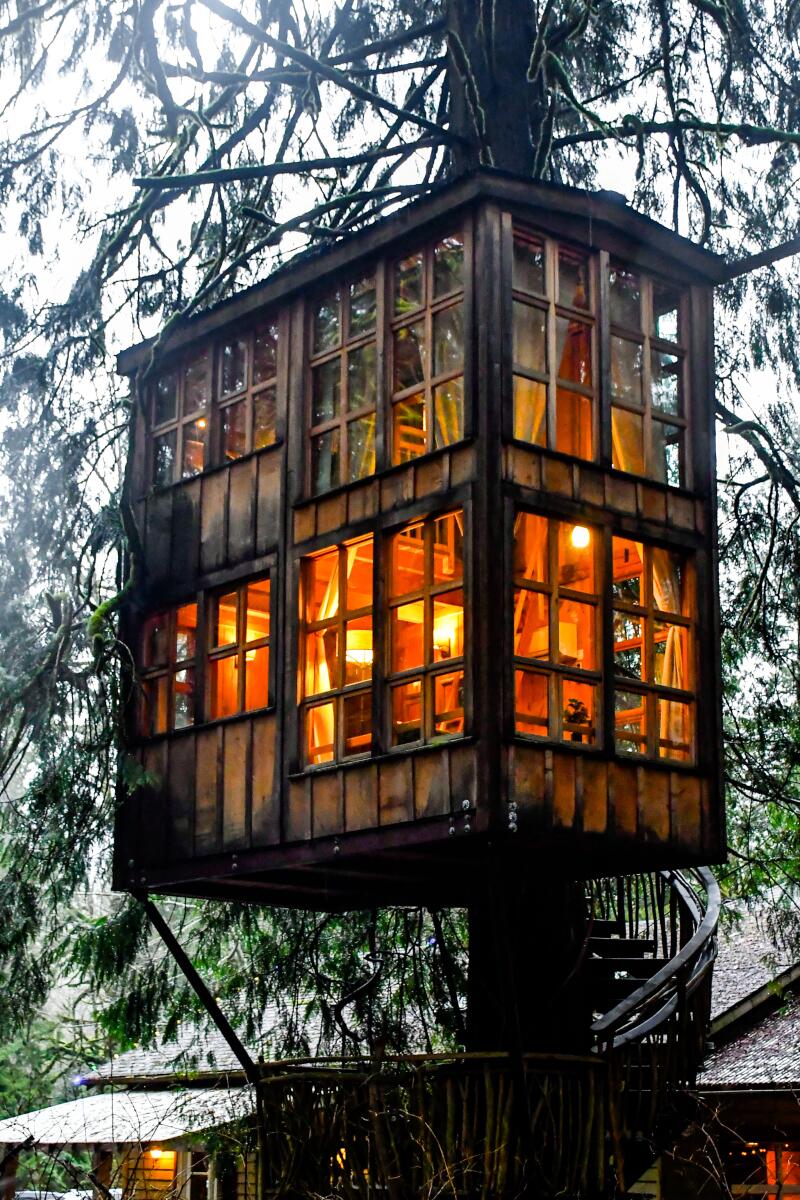
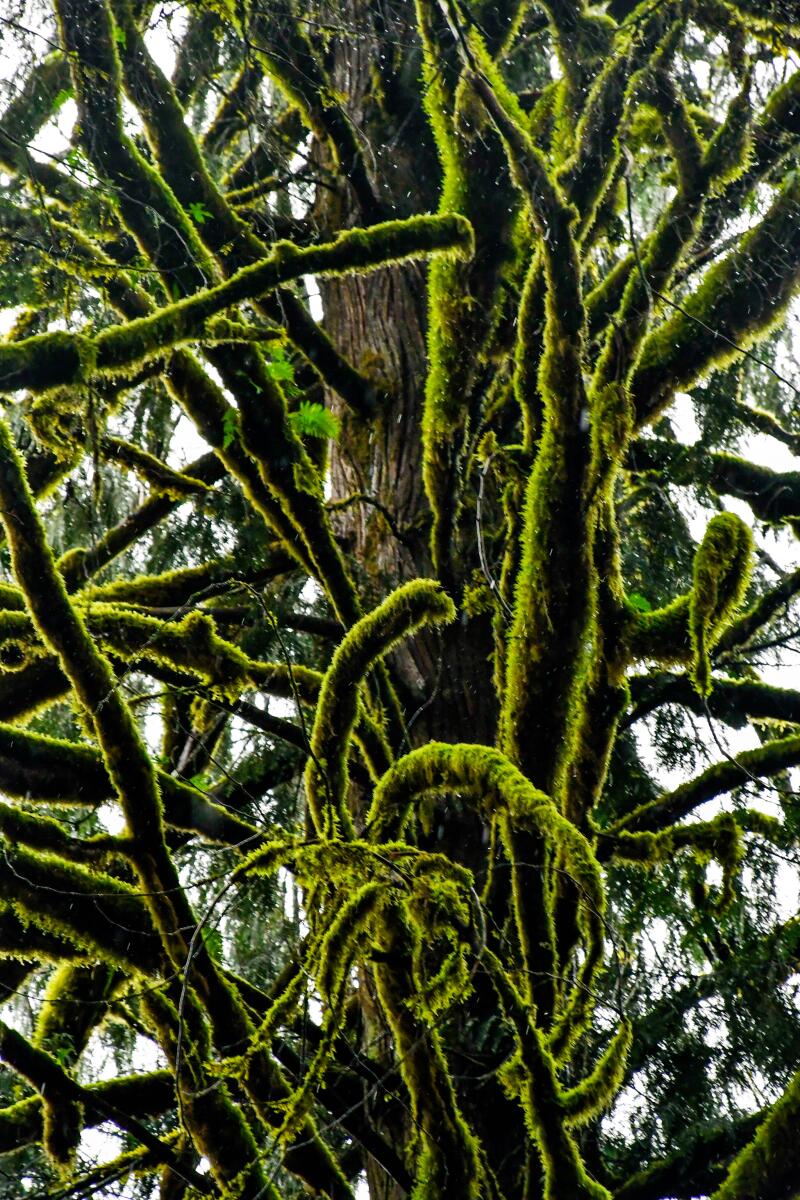
Treehouse Point’s Trillium unit features 80 panes of glass. The damp weather — and mists from the neighboring river — makes for a thick forest with branches draped in green. (Christopher Reynolds / Los Angeles Times)
If you go
Treehouse Point is at 6922 Preston-Fall City Road SE, Issaquah, near Fall City, Wash.
Once you get onto the Treehouse Point property, you won’t want to leave. But there’s no restaurant on-site. So you’ll need to head back out for dinner or bring a picnic. In coming weeks, Monahan said, she hopes to introduce more food options (perhaps charcuterie boards) to go with the drinks, beers and wines offered in the lodge‘s specialty shop.
If you go out for dinner, the fanciest nearby option is the Salish Lodge, a historic hotel and restaurant above Snoqualmie Falls, about 15 minutes away. The most rustic alternative is the Last Frontier Saloon in Fall City, about five minutes from Treehouse Point.
Having had lunch at the lodge (tasty chowder) and a midafternoon beer at the saloon (spicy banter), I met friends for a satisfying dinner at Well & Table, a pleasant locavore restaurant (main dishes $18 to $39) that’s 15 minutes away in Issaquah.
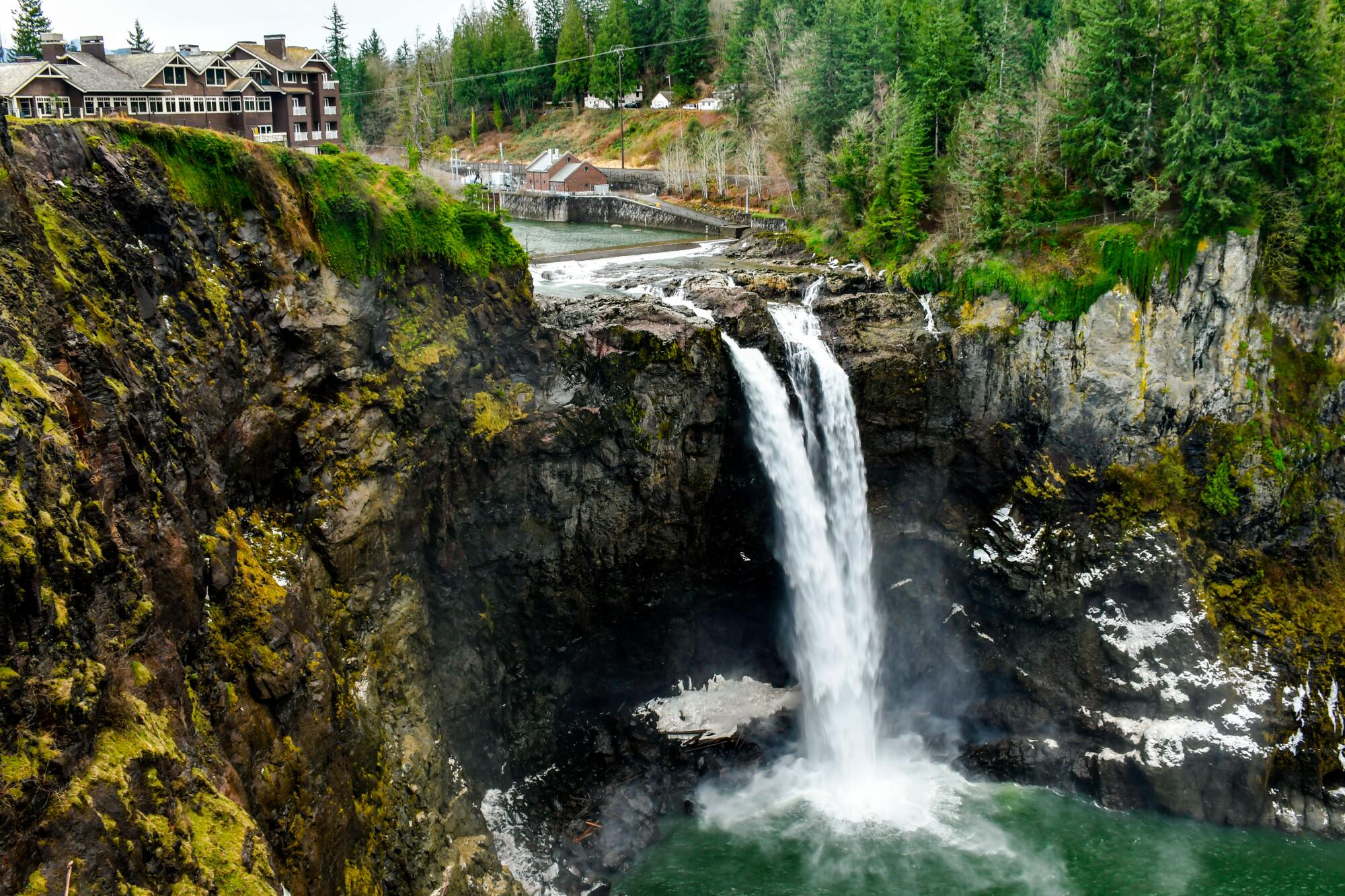
More to Read
Sign up for The Wild
We’ll help you find the best places to hike, bike and run, as well as the perfect silent spots for meditation and yoga.
You may occasionally receive promotional content from the Los Angeles Times.
